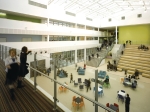They were the future once
The press are eager to inform us about free schools perceived to be failing. This is understandable: free schools are the flagship reform of a current government minister and their troubles make good news stories.
However there are schools across the country that are failing, many of which were once flagship examples of an altogether different vintage of government policy. Building Schools for the Future (BSF) began in 2005, and coincided with an enthusiastic revival in progressive education during the New Labour years. These were the heady days of personalisation, independent learning, multiple intelligences, SEAL, learning styles, 21st century skills and thinking hats. Many new BSF schools were built at extravagant costs to fulfil such a vision.
Here are just four examples where immensely well financed visions of progressive education have resulted in embarrassing failure.
Litherland High School
Then: In 2011, Litherland High School reopened in a new £27 million building. The curriculum was based on ‘21st century learning’ in a ‘global learning community’, and at Key Stage 3 it taught a cross-curricular programme called L3 (Language, Life and Learning). IT resources alone cost £2.2 million, allowing for 700 computer devices including iPods, iPads and laptops. The school presented at the DFES-organised conference Classroom of the Future, and gained an International School Award. In 2011, Litherland High School was graded ‘Outstanding’ by Ofsted, who praised the teaching for its promotion of ‘independent learning’, though the school’s attainment and attendance were ‘broadly average’.
Now: GCSE results at Litherland High School have declined from 48% of pupils gaining 5 good GCSEs in 2011, to 42% in 2012 to 38% in 2013, placing it in the lowest quintile for similar schools in English, mathematics and overall results. In February 2014, Litherland High School was inspected, graded ‘Inadequate’ and placed in special measures. The report states classwork is often unfished, marking is variable, pupil litter is a problem, students talk and play on their phones in class, and that the school inappropriately identifies pupils with having behavioural special needs.
The Voyager Academy
Then: Formed in 2007 by a merger of two schools, the Voyager Academy’s ‘innovative’ building was based around a central open social zone and cost £26 million, with a capacity for 1,700 pupils. The previous year, it launched its uniform (based around the concept of ‘identity’) in a pupil catwalk show, gained £1 million through media arts specialist status, and was Peterborough’s first school to appoint pupils to the board of governors. The head was Hugh Howe OBE, credited with turning around numerous failing schools.
Now: The school was inspected in February 2014, graded ‘Inadequate’, and placed in special measures. The report observed: ‘Too many teachers have low expectations of students. This means they tolerate work and behaviour that is well below what is acceptable.’ The ‘disrespectful’ behaviour of the pupils was said to have a ‘significant impact on learning’, with swearing, smoking, poor punctuality and internal truancy highlighted. In summer 2013, only 42% of pupils gained five good grades at GCSEs.
Knowsley, Merseyside
Then: In 2009, the local council spent £157 million rebranding its seven schools as ‘centres of learning’. These ‘centres’ promised to ‘rip up the rulebook’: teachers were renamed ‘progress leaders’; classrooms became ‘homebases’ and ‘warehouses’; and a ‘world class’ education was promised for the pupils. The head of one school, Huyton Arts and Sports Centre for Learning, declared that they would not be teaching knowledge, as children can now ‘sit on Google and find out anything at the push of a button’.
Now: Three years after the ‘centres of learning’ rebrand, Knowsley was the worst performing local authority in the country at GCSE. In July 2013, only 381 of the 900 places at Christ the King Catholic and Church of England Centre for Learning (cost £24 million) were filled, and the school has since closed. In summer 2013, only 35% of the pupils at Huyton Arts and Sports Centre for Learning gained five good GCSEs, and it was in the lowest quintile for similar schools in maths, English and overall results. The school is due to close, and reopen as the Lord Derby Academy.
New Line Learning Academy (motto: Tomorrow’s Future Today)
Then: This Kent academy was opened by executive head Dr Chris Gerry in 2007, guided by his philosophy of New Line Learning (NLL). Gerry, who once co-authored a pamphlet with progressive guru David Hargreaves, described NLL as a departure from ‘traditional approaches’, with a focus on ‘project based learning’, ‘meta questions’ and working ‘independently’. The school introduced ‘learning plazas’ where 90 pupils could be taught by teams of teachers, and teachers were encouraged to work ‘less as subject specialists and more as mentors and guides for students’. In 2008, the TES reported that Dr Gerry was designing a curriculum around ‘emotional intelligence’, and had sent 16 teachers to Yale University to train as ‘emotional intelligence coaches’.
Now: In 2010, it was reported that New Line Learning Academy had the worst truancy record in the entire country, with 27 per cent of pupils regularly absent from school. In 2013, only 40% of the school’s pupils gained five good GCSEs, and the school had more than 40% of its year 7 places vacant for the start of term in September.
These are just four examples, but I am sure there are many more BSF schools which have suffered a similar fate.
In each case, no expense was spared in allowing progressive educators to fulfil their vision of a technologically advanced, collaborative, child-centred, 21st century learning environment. In each case, the schools have been a disaster. The national papers have broadly ignored their failure, but for those interested in pedagogy, this is the real school scandal from the last ten years of reform.





I think it’s important to point out that other schools fail and that free schools are no different to other prior policies. There is an issue with picking out BSFs, especially flagship academies, which is that they specifically targeted some of the most deprived and difficult areas – hence, they were always facing an uphill climb. Part of the reason for pushing forward with technology, fancy buildings, etc, was because students didn’t have access to those things elsewhere. Often their home conditions will have been cramped and their access to technology limited. Those might not have a direct impact on, say, GCSE results, but they are factors of multiple deprivation which lead to social exclusion and can ultimately affect what jobs students get (and how healthy and happy they are in life) just as much as GCSEs do – and hence need to be taken into consideration when we think about the success of these schools.
Free schools, particularly in the first round, tended to have demographics that were slightly higher income than the areas they were placed in, and did not have the same multiple deprivation barriers. If anything the argument was that they were going to be ‘as good as the best’ by emulating private schools and would therefore somehow be way superior to local comprehensives. In the case of the BSF, sometimes they were just battling to even get kids through the doors.
As I say, none of this means that you shouldn’t point out the failures, or that it’s okay that such expense was paid and things haven’t improved as much as planned. But the context is worth bearing out lest we should draw overly simplistic conclusions between what looks like ‘trendiness’ and low GCSE results.
True, the original city academies did target deprived areas. However, if we compare the fate of these schools with ones which have a ‘no excuses’ school ethos, I’m thinking in particular the Harris and Ark chains, it makes for a pretty stark contrast. These schools have been established in similarly deprived areas, at a similar time, and most have done extremely well. See Harris Academy in Crystal Palace which is the most oversubscribed non-grammar or faith schools in the country. 12 applicants for every place, versus the schools above which can’t even fill their rolls!
http://www.telegraph.co.uk/education/educationnews/9729674/Top-state-schools-flooded-with-over-1000-applications.html
What I offer is not empirical evidence (it is hard to think of how a survey could be designed which measures schools for ‘trendiness’) but it does strike me as pretty suggestive.
There are also examples of similar chains *not* doing well. (And even examples within good chains of schools that are quite disasterous). We can sometimes make a dangerous assumption that because we see something successful and it has certain qualities (i.e. there *are* high-performing no excuses schools) that it is those qualities making the difference. But the problem is that we can find other schools that look to be doing the same thing and yet are really struggling.
Likewise, I could point you to Summerhill – the maddest and truest of all Progressive schools – and show you the evidence that it has been wildly over-subscribed since it moved to England in the late 20s. Even in the after-war period when private schools fell at a rate of knots, Summerhill had an enormous waitlist.
Hence I think it’s possible, and important, that we allow other factors to be at play here and weigh up their impact also.
Hmmn. With regards to Summerhill, I would be very interested in seeing that evidence. My impression was that it has never had anything more than around 70 pupils. In Robert Skidelsky’s book ‘English Progressive Schools’ (1969) he visits Summerhill, meets Neill, and writes that the place had such difficulty attracting pupils, that it very nearly closed down during the 1960s. It was only saved from closure by an influx of American students, off the back of the enormous popularity of Neill’s book ‘Summerhill’.
AS Neill’s personal correspondence (now published and available in archive) references the issue pretty much throughout the entire period he was alive and in charge. I have a copy of the 1969 Skidelsky here and, as far as I can see, he gives no evidence for this argument that Summerhill was ‘saved’ by the book but uses it as a way to explain why Summerhill survived while the others were folding. Having studied Summerhill fairly closely for another project* I’d argue it is fair to say that the book enormously influenced the population, and it enabled Neill to charge far higher funds (one of the issues of taking ‘problem children’ was that they often came from ‘problem families’ and that brings financial instabilities – again, well documented in Neill’s correspondence) but Skidelsky questions if the school can continue after his death. It has, of course, and the after-glow of its publications are also long burnt out.
A better argument made by Skidelsky is that the extreme Progressivism of Summerhill only works for the emotionally ‘problematic’ and once that is solved they are ‘whisked away’. Hence, it’s not a good solution for the country at large. There is something in this, I think. But when schools take all pupils – as they mostly do – then it may be that there needs to be at least a moderate amount of the ‘touchy-feely’ stuff to what schools do too.
[In case you’re interested, the project was this: http://lauramcinerney.com/2012/09/25/review-of-progressive-school-movement-summerhill-malting-house-beacon-hill/. I actually found that the relationships and identities of the founders was the most important aspect of their survival. This is what caused me to become so interested in free school founders].
Given that a previous much hyped golden age failed to materialise with BSF, why are we expecting Academy schools and Free Schools to be any better?
Aren’t we all a bit fed up with promises that this time it will be different?
I am not oppossed to Academy schools or Free Schools, just oppossed to being presented with another magic wand.
Reblogged this on The Echo Chamber.